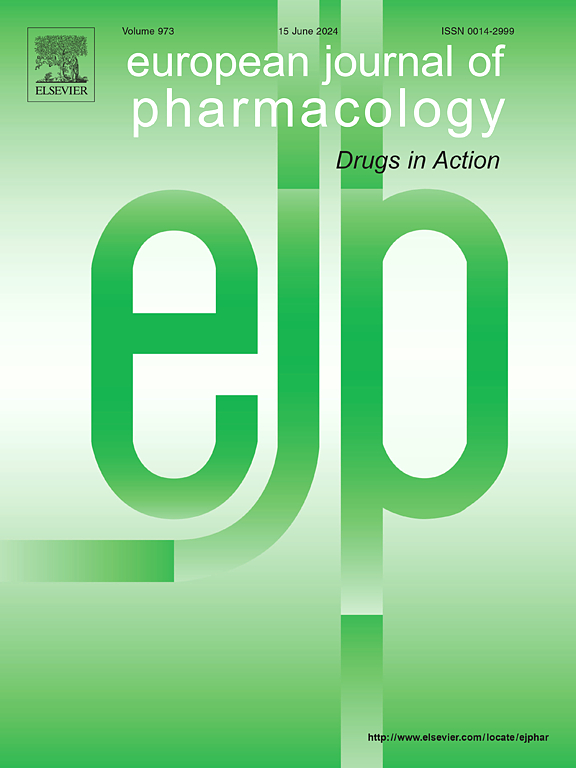Agomelatine attenuates dexamethasone-induced neurotoxicity in rats through the activation of MT1/2 receptors and attenuation of oxidative stress
IF 4.2
3区 医学
Q1 PHARMACOLOGY & PHARMACY
引用次数: 0
Abstract
Previous studies showed that agomelatine ameliorates doxorubicin-induced brain injury in rats. Furthermore, it protects neurons against oxidative stress triggered by acute ischemia reperfusion injury. So, this study aimed to investigate the possible neuroprotective effects of agomelatine on dexamethasone-induced neurotoxicity in rats and the underlying mechanisms. Subcutaneous injections of dexamethasone (10 mg/kg, 4 days) were used to induce neurotoxicity in rats. Agomelatine (10 mg/kg), luzindole (2.5 mg/kg, a melatonin receptor blocker), and luzindole plus agomelatine treatment commenced 3 days before dexamethasone injections and concurrent with dexamethasone injections. Elevated plus maze test, Y-maze test and open field test were carried out after 1 h of the last dose of dexamethasone on day 7. On 8th day of the experiment, brain tissues were collected. Brain oxidative stress markers, immunohistochemical expression of β-amyloid and glial fibrillary acidic protein (GFAP) were measured. Moreover, histopathological changes in the cerebral cortex and hippocampus were recorded and the number of damaged cells was counted. Dexamethasone increased anxiety and memory impairment but decreased locomotor exploration activity. Furthermore, it increased brain oxidative stress, expression of β-amyloid and GFAP, increased the number of damaged neurons, and caused structural changes in cerebral cortex and hippocampus. All these deleterious changes were mitigated by agomelatine. Luzindole prior administration to agomelatine reversed the protective effects of agomelatine except its effect on lipid peroxidation. Collectively, these findings suggest that agomelatine can protect against dexamethasone-induced neurotoxicity partially by activating melatonin receptors in addition to exerting antioxidant effects.
阿戈美拉汀通过激活MT1/2受体和减弱氧化应激来减轻地塞米松诱导的大鼠神经毒性
既往研究表明阿戈美拉汀可改善阿霉素所致大鼠脑损伤。此外,它还能保护神经元免受急性缺血再灌注损伤引起的氧化应激。因此,本研究旨在探讨阿戈美拉汀对地塞米松致大鼠神经毒性可能的神经保护作用及其机制。采用地塞米松皮下注射(10 mg/kg, 4 d)诱导大鼠神经毒性。阿戈美拉汀(10mg /kg)、卢齐多(2.5 mg/kg,一种褪黑激素受体阻滞剂)和卢齐多加阿戈美拉汀治疗在地塞米松注射前3天开始,同时注射地塞米松。第7天末次地塞米松给药1 h后进行升高+迷宫试验、y型迷宫试验和空地试验。实验第8天采集脑组织。测定脑氧化应激标志物、β-淀粉样蛋白和胶质原纤维酸性蛋白(GFAP)的免疫组化表达。记录大鼠大脑皮层和海马组织病理变化,计数损伤细胞数量。地塞米松增加了焦虑和记忆障碍,但减少了运动探索活动。增加脑氧化应激,增加β-淀粉样蛋白和GFAP的表达,增加受损神经元数量,引起大脑皮层和海马结构改变。阿戈美拉汀减轻了所有这些有害的变化。除了对脂质过氧化的影响外,卢辛多先前给药阿戈美拉汀逆转了阿戈美拉汀的保护作用。总的来说,这些发现表明阿戈美拉汀除了发挥抗氧化作用外,还可以通过激活褪黑激素受体来部分保护地塞米松诱导的神经毒性。
本文章由计算机程序翻译,如有差异,请以英文原文为准。
求助全文
约1分钟内获得全文
求助全文
来源期刊
CiteScore
9.00
自引率
0.00%
发文量
572
审稿时长
34 days
期刊介绍:
The European Journal of Pharmacology publishes research papers covering all aspects of experimental pharmacology with focus on the mechanism of action of structurally identified compounds affecting biological systems.
The scope includes:
Behavioural pharmacology
Neuropharmacology and analgesia
Cardiovascular pharmacology
Pulmonary, gastrointestinal and urogenital pharmacology
Endocrine pharmacology
Immunopharmacology and inflammation
Molecular and cellular pharmacology
Regenerative pharmacology
Biologicals and biotherapeutics
Translational pharmacology
Nutriceutical pharmacology.

 求助内容:
求助内容: 应助结果提醒方式:
应助结果提醒方式:


